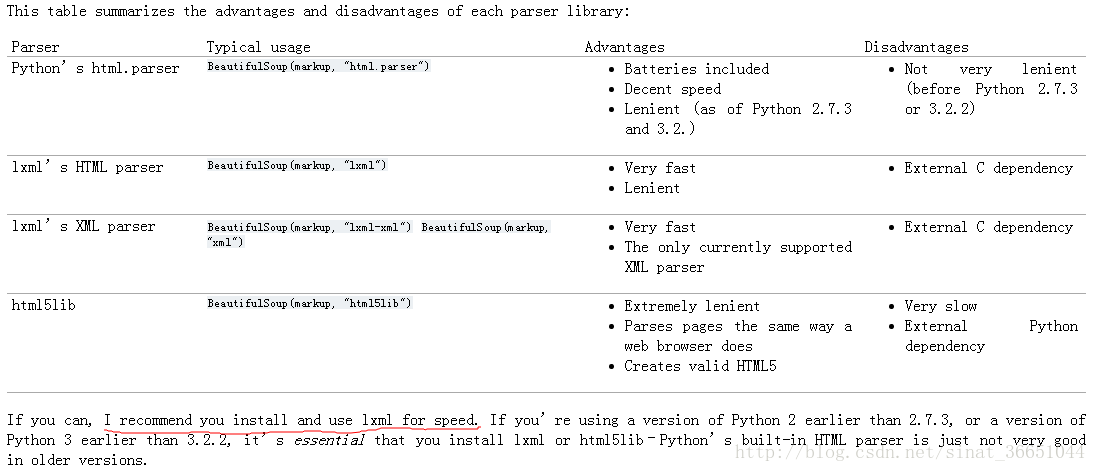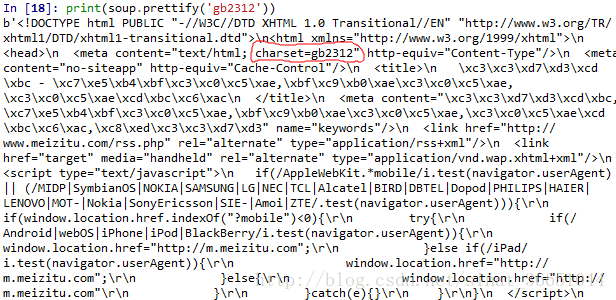概述
1 parsers
刚看bs4文档,就看到这样的代码:
>>> from bs4 import BeautifulSoup
>>> soup = BeautifulSoup(html_doc,"html.parser")
>>> soup.a
<a class="sister" href="http://example.com/elsie" id="link1">Elsie</a>这里的html.parser是Python标准库中的HTML解析器。BeautifulSoup还支持第三方的解析器,比如lxml和html5lib。
一般来说,lxml解析速度最快,效果会更好。

截图来自https://www.crummy.com/software/BeautifulSoup/bs4/doc/#installing-a-parser
2 Encodings
每个网页都有一种特定的编码方式,国内常用的网页编码方式有utf-8和gb2312两种。
使用BeautifulSoup解析后,文档都会被转换成Unicode。
2.1 网页源码的前几行会有相关的编码信息:
<meta charset="utf-8"><meta http-equiv="Content-Type" content="text/html; charset=gb2312" />2.2 original_encoding属性记录了自动识别编码的结果
In [7]: soup.original_encoding
Out[7]: 'gb2312'2.3 通过Beautiful Soup输出文档时,不管输入文档是什么编码方式,输出编码均为UTF-8编码:

如果不想用utf-8格式输出,可以自己传入编码方式参数:

2.4 UnicodeDammit
A class for detecting the encoding of a *ML document and converting it to a Unicode string. If the source encoding is windows-1252, can replace MS smart quotes with their HTML or XML equivalents.
>>> from bs4 import UnicodeDammit
>>> dammit = UnicodeDammit("Sacrxc3xa9 bleu!")
>>> print(dammit.unicode_markup)
Sacré bleu!
>>> dammit.original_encoding
>>>
>>> snowmen = (u"N{SNOWMAN}" * 3)
>>> quote = (u"N{LEFT DOUBLE QUOTATION MARK}I like snowmen!N{RIGHT DOUBLE QUOTATION MARK}")
>>> doc = snowmen.encode("utf8") + quote.encode("windows_1252")
>>> print(doc)
b'xe2x98x83xe2x98x83xe2x98x83x93I like snowmen!x94'
>>> print(doc.decode("windows_1252"))
☃☃☃“I like snowmen!”
>>>
>>>
>>> new_doc = UnicodeDammit.detwingle(doc)
>>> print(new_doc.decode('utf-8'))
☃☃☃“I like snowmen!”
>>> UnicodeDammit.detwingle() 方法能解码包含在UTF-8编码中的Windows-1252编码内容,这已经解决了最常见的一类问题.
在创建 BeautifulSoup 或 UnicodeDammit 对象前一定要先对文档调用 UnicodeDammit.detwingle() 确保文档的编码方式正确。如果尝试去解析一段包含Windows-1252编码的UTF-8文档,就会得到一堆乱码,比如: ☃☃☃“I like snowmen!”。
>>> help(UnicodeDammit)
Help on class UnicodeDammit in module bs4.dammit:
class UnicodeDammit(builtins.object)
| A class for detecting the encoding of a *ML document and
| converting it to a Unicode string. If the source encoding is
| windows-1252, can replace MS smart quotes with their HTML or XML
| equivalents.
|
| Methods defined here:
|
| __init__(self, markup, override_encodings=[], smart_quotes_to=None, is_html=False, exclude_encodings=[])
| Initialize self. See help(type(self)) for accurate signature.
|
| find_codec(self, charset)
|
| ----------------------------------------------------------------------
| Class methods defined here:
|
| detwingle(in_bytes, main_encoding='utf8', embedded_encoding='windows-1252') from builtins.type
| Fix characters from one encoding embedded in some other encoding.
|
| Currently the only situation supported is Windows-1252 (or its
| subset ISO-8859-1), embedded in UTF-8.
|
| The input must be a bytestring. If you've already converted
| the document to Unicode, you're too late.
|
| The output is a bytestring in which `embedded_encoding`
| characters have been converted to their `main_encoding`
| equivalents.
......
最后,Python中安装了 chardet 或 cchardet 那么编码检测功能的准确率将大大提高。
3 diagnose()
使用diagnose()方法,BeautifulSoup会输出一份报告,说明不同的解析器会怎样处理这段文档,并标出当前的解析过程会使用哪种解析器:
In [19]: test_doc = "xc3xc3xd7xd3xcdxbc - xc7xe5xb4xbfxc3xc0xc5xae,xbfxc9xb0xaexc3xc0xc5xae,xc3xc0xc5xaexcdxbcxc6xac"
...:
In [20]: from bs4.diagnose import diagnose
In [21]: diagnose(test_doc)
Diagnostic running on Beautiful Soup 4.6.0
Python version 3.6.1 |Anaconda 4.4.0 (32-bit)| (default, May 11 2017, 14:16:49) [MSC v.1900 32 bit (Intel)]
Found lxml version 3.7.3.0
Found html5lib version 0.999
Trying to parse your markup with html.parser
Here's what html.parser did with the markup:
ÃÃ×Óͼ - Çå´¿ÃÀÅ®,¿É°®ÃÀÅ®,ÃÀŮͼƬ
--------------------------------------------------------------------------------
Trying to parse your markup with html5lib
Here's what html5lib did with the markup:
<html>
<head>
</head>
<body>
ÃÃ×Óͼ - Çå´¿ÃÀÅ®,¿É°®ÃÀÅ®,ÃÀŮͼƬ
</body>
</html>
--------------------------------------------------------------------------------
Trying to parse your markup with lxml
Here's what lxml did with the markup:
<html>
<body>
<p>
ÃÃ×Óͼ - Çå´¿ÃÀÅ®,¿É°®ÃÀÅ®,ÃÀŮͼƬ
</p>
</body>
</html>
--------------------------------------------------------------------------------
Trying to parse your markup with ['lxml', 'xml']
Here's what ['lxml', 'xml'] did with the markup:
<?xml version="1.0" encoding="utf-8"?>
--------------------------------------------------------------------------------
C:ProgramDataAnaconda3libsite-packagesbs4__init__.py:181: UserWarning: No parser was explicitly specified, so I'm using the best available XML parser for this system ("lxml-xml"). This usually isn't a problem, but if you run this code on another system, or in a different virtual environment, it may use a different parser and behave differently.
The code that caused this warning is on line 231 of the file C:ProgramDataAnaconda3libsite-packagesspyderutilsipythonstart_kernel.py. To get rid of this warning, change code that looks like this:
BeautifulSoup(YOUR_MARKUP})
to this:
BeautifulSoup(YOUR_MARKUP, "lxml-xml")
markup_type=markup_type))最后
以上就是难过发箍为你收集整理的BeautifulSoup学习笔记7的全部内容,希望文章能够帮你解决BeautifulSoup学习笔记7所遇到的程序开发问题。
如果觉得靠谱客网站的内容还不错,欢迎将靠谱客网站推荐给程序员好友。

![BeautifulSoupu’b’u’boldest’{u’class’: u’boldest’}u’Extremely bold’
No longer bold
u’[document]’u’Hey, buddy. Want to buy a used parser’
The Dormouse’s storyThe Dormouse’s storyThe Dormouse’s storyElsie[Elsie,Lacie,Tillie]The Dormouse’s storyThe](/uploads/reation/bcimg10.png)






发表评论 取消回复